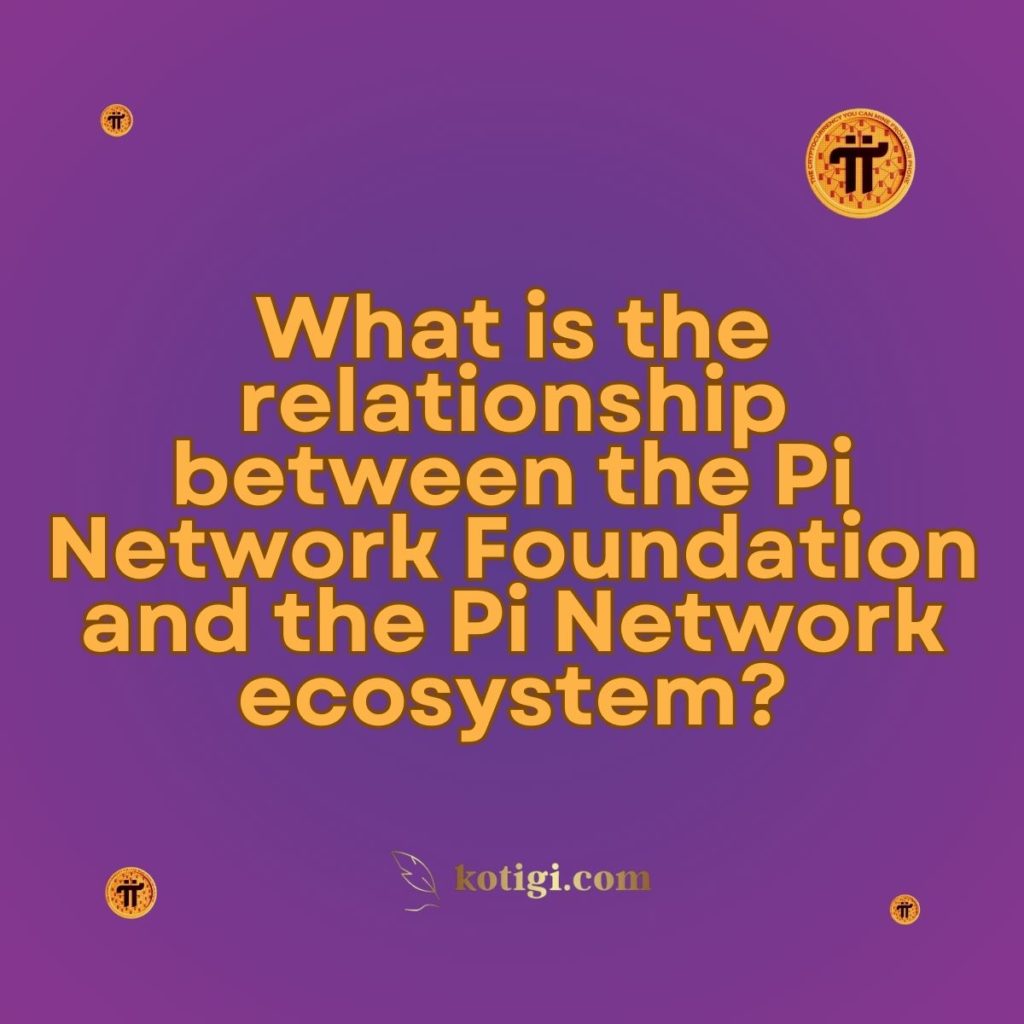
What is the relationship between the Pi Network Foundation and the Pi Network ecosystem?
The Pi Network Foundation serves as the governing body that oversees the development and growth of the Pi Network ecosystem. This ecosystem includes a wide range of participants, applications, and decentralized services, all working together to build a functional and scalable blockchain network. The relationship between the Foundation and the ecosystem is symbiotic: the Foundation provides strategic direction, governance, and resources, while the ecosystem participants contribute to the platform’s growth, innovation, and decentralization.
Introduction
As the Pi Network continues to grow and attract millions of users worldwide, its ecosystem is rapidly evolving into a robust decentralized environment. But what exactly is the relationship between the Pi Network Foundation and the Pi Network ecosystem? For those unfamiliar, the ecosystem encompasses everything from the users and developers to the decentralized applications (dApps) and services built on the Pi blockchain. At the core of this dynamic system lies the Pi Network Foundation, which acts as the primary governing body overseeing its development and sustainability. In this article, we will explore how the Foundation and the ecosystem work together, their mutual dependencies, and why this relationship is crucial for the long-term success of Pi Network.
The Role of the Pi Network Foundation
The Pi Network Foundation plays a central role in shaping the overall direction, governance, and success of the Pi Network. Much more than just an administrative body, the Foundation is responsible for creating a sustainable and decentralized ecosystem where Pioneers (Pi users), developers, and businesses can thrive. Its actions set the tone for how the entire Pi ecosystem evolves, grows, and adapts to changing technological and market trends.
Governance and Leadership
At its core, the Pi Network Foundation is tasked with guiding the ecosystem toward a decentralized future. It sets the rules, frameworks, and structures that define how the ecosystem operates. Through its leadership, the Foundation ensures that Pi Network remains decentralized, user-focused, and innovative. Governance involves making strategic decisions that affect the platform, such as protocol upgrades, partnerships, and the introduction of new features. Without the Foundation’s oversight, the ecosystem might lack the coherence and strategic direction needed for long-term success.
Ecosystem Development
The Foundation doesn’t just manage Pi Network’s blockchain; it actively fosters the growth of the broader ecosystem. This involves supporting and facilitating developers, businesses, and services that contribute to the platform. Through partnerships and grants, the Foundation encourages developers to create decentralized applications (dApps), marketplaces, and other services that add value to the Pi ecosystem. By promoting such development, the Foundation ensures that Pi Network becomes more than just a cryptocurrency—it becomes a thriving digital economy.
Financial Oversight
Another critical role of the Pi Network Foundation is financial oversight. The Foundation manages the network’s finances to ensure that funds are allocated appropriately for the growth and development of the ecosystem. This includes supporting developers through funding, investing in infrastructure improvements, and ensuring that resources are available for network maintenance and innovation. By maintaining financial transparency and responsibility, the Foundation helps build trust among ecosystem participants and ensures the long-term sustainability of the Pi Network.
What Constitutes the Pi Network Ecosystem?
The Pi Network ecosystem is a complex and ever-growing network that includes users, developers, decentralized applications, and services that contribute to the functionality and growth of the platform. Unlike traditional ecosystems, which may rely heavily on centralized control, the Pi Network ecosystem aims for decentralization, where various participants contribute to the network’s development and governance.
Pioneers (Users)
At the heart of the Pi Network ecosystem are the Pioneers, the users who mine Pi on their mobile phones. These individuals form the backbone of the network, helping to secure it through their participation. Pioneers are also consumers of the services and applications built on the Pi blockchain, making them a critical component of the ecosystem’s growth. As more users join the network, the ecosystem becomes stronger and more decentralized, driving adoption and creating demand for new services.
Developers and dApps
Another significant part of the Pi Network ecosystem is its developer community. Developers are responsible for creating decentralized applications (dApps) and other services that run on the Pi blockchain. These applications range from financial tools to social media platforms, and their development is key to expanding the network’s utility. The Pi Network Foundation actively supports developers through tools, resources, and even grants to encourage innovation within the ecosystem. By enabling developers to build on Pi, the Foundation ensures that the network remains dynamic and capable of meeting the diverse needs of its users.
Businesses and Marketplaces
In addition to developers, businesses are also becoming a vital part of the Pi Network ecosystem. Various businesses are exploring ways to accept Pi as a form of payment, creating marketplaces and services that utilize Pi as a currency. The Foundation is working to create partnerships with these businesses, integrating them into the Pi Network ecosystem. As more businesses adopt Pi, the ecosystem grows stronger, providing real-world utility and fostering an economy powered by Pi.
How the Pi Network Foundation Supports the Ecosystem?
The Pi Network Foundation’s relationship with the ecosystem is not passive. It actively works to support and enhance the ecosystem in several ways, including providing development tools, resources, and partnerships that facilitate growth.
Development Tools and Infrastructure
The Pi Network Foundation ensures that developers have the tools and infrastructure needed to build dApps and services on the Pi blockchain. This includes providing software development kits (SDKs), application programming interfaces (APIs), and detailed documentation to help developers create decentralized applications. By making it easier for developers to build on Pi, the Foundation encourages the creation of new services that enrich the ecosystem.
Grants and Funding
One of the ways the Pi Network Foundation fosters innovation is by providing grants and funding to developers and businesses that contribute to the ecosystem. These financial resources help fuel the creation of new applications and services, ensuring that Pi Network continues to grow and expand. By investing in the ecosystem, the Foundation ensures that it remains dynamic and competitive, encouraging further development and adoption.
Partnerships and Collaborations
The Pi Network Foundation actively seeks out partnerships and collaborations that can benefit the ecosystem. Whether it’s partnering with other blockchain platforms, businesses, or institutions, the Foundation looks for opportunities that enhance the utility and adoption of Pi. These partnerships help bring real-world use cases to the Pi ecosystem, giving Pioneers more reasons to engage with the network.
How the Ecosystem Benefits the Foundation?
The relationship between the Pi Network Foundation and the ecosystem is symbiotic. Just as the Foundation supports the ecosystem, the ecosystem in turn benefits the Foundation by driving network adoption, decentralization, and utility. A thriving ecosystem ensures the long-term success of the network, providing the Foundation with the necessary feedback and engagement to guide its decision-making processes.
Adoption and Growth
One of the most significant ways the ecosystem benefits the Foundation is by driving adoption and growth. As more users, developers, and businesses join the Pi Network, the platform becomes more valuable. This increased adoption provides the Foundation with the data and resources needed to make informed decisions about the network’s future. Additionally, a growing ecosystem helps to strengthen Pi’s market position, making it more competitive in the broader cryptocurrency space.
Decentralization
Decentralization is a core principle of the Pi Network, and the ecosystem plays a vital role in achieving this goal. By allowing various participants to contribute to the network’s development and governance, the ecosystem helps to distribute power and control away from any single entity, including the Foundation. This decentralization ensures that Pi Network remains true to its mission of creating a decentralized digital economy, where users and developers play an active role in shaping the platform’s future.
Innovation and Utility
The more robust and dynamic the ecosystem, the more utility and innovation it brings to the Pi Network. With developers creating new dApps and businesses adopting Pi as a currency, the platform becomes more useful to its users. This added utility encourages more people to join the network, further strengthening the ecosystem. The Foundation benefits from this innovation as it provides the platform with new use cases and opportunities for growth.
The Challenges of Growing a Decentralized Ecosystem
While the relationship between the Pi Network Foundation and the ecosystem is mutually beneficial, it also comes with its challenges. Growing and maintaining a decentralized ecosystem requires careful planning, coordination, and the ability to adapt to new challenges as they arise.
Balancing Decentralization and Governance
One of the primary challenges is balancing decentralization with effective governance. While the Foundation must maintain oversight to ensure the network’s success, it also needs to allow the ecosystem to evolve organically. Striking the right balance between these two aspects is crucial for ensuring that Pi Network remains decentralized while still growing in a sustainable and secure manner.
Scalability
As the Pi Network ecosystem grows, scalability becomes a pressing issue. The Foundation and ecosystem participants must work together to ensure that the network can handle increased demand without compromising performance or security. This requires ongoing investment in infrastructure, tools, and resources to support the ecosystem’s growth.
Regulatory Compliance
As with any blockchain project, regulatory compliance is an ongoing challenge. The Pi Network Foundation must navigate a complex and ever-changing regulatory landscape while ensuring that the ecosystem remains compliant. This can be particularly challenging as the ecosystem grows and becomes more decentralized, making it harder to enforce uniform compliance across all participants.
Conclusion
The relationship between the Pi Network Foundation and the Pi Network ecosystem is one of mutual dependency and collaboration. The Foundation provides governance, resources, and strategic direction, while the ecosystem contributes to the network’s growth, decentralization, and utility. Together, they form a dynamic partnership that is driving the evolution of Pi Network into a fully decentralized, scalable, and user-friendly platform. As the ecosystem continues to expand, the Foundation’s role in guiding and supporting it will be crucial in ensuring the long-term success of Pi Network.
Key Takeaways
- The Pi Network Foundation oversees the governance, development, and strategic direction of the Pi Network ecosystem.
- The ecosystem includes users (Pioneers), developers, businesses, and decentralized applications (dApps) that contribute to the network’s growth.
- The Foundation actively supports the ecosystem through development tools, grants, and partnerships, ensuring that it continues to expand and innovate.
- A thriving ecosystem benefits the Foundation by driving adoption, decentralization, and innovation, which are crucial for Pi Network’s success.
- Challenges such as balancing decentralization with governance, scalability, and regulatory compliance must be addressed for the ecosystem to continue growing sustainably.





